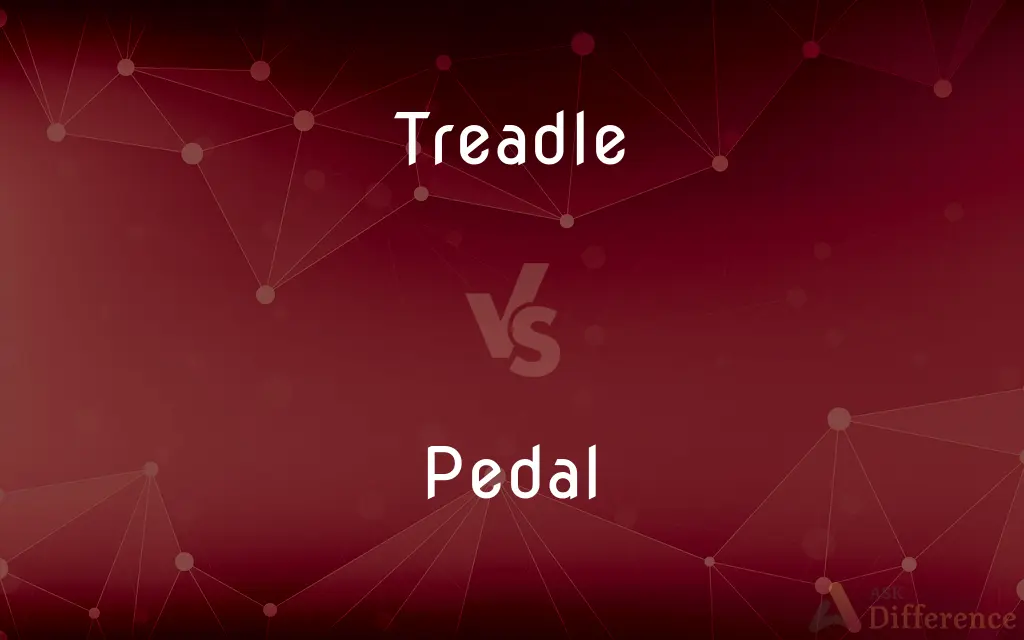Treadle vs. Pedal — What's the Difference?
By Fiza Rafique & Maham Liaqat — Updated on April 15, 2024
A treadle is a lever operated by foot to drive machinery, relying on a back-and-forth motion; a pedal, on the other hand, usually refers to a foot-operated lever that rotates to power bicycles or control devices.

Difference Between Treadle and Pedal
Table of Contents
ADVERTISEMENT
Key Differences
Treadle mechanisms are typically found in older or specialized equipment like sewing machines or looms, where a foot motion drives the machine via a rocking action. Whereas, pedals are commonly associated with bicycles and vehicles, where they transfer rotary motion to propel or control the machine.
A treadle requires the user to push down with a foot in a repeated motion, which may be linked to a larger mechanical system via belts or rods. On the other hand, a pedal requires pushing in a circular motion, directly connected to cranks or a wheel, facilitating continuous movement.
In terms of design, treadles often form part of a stationary setup where the operator is seated or standing in one place. While, pedals are part of mobile equipment, designed to be operated while the user is typically sitting or standing on the moving device itself.
Usage contexts also differ; treadles are often seen in industrial or craft settings, emphasizing controlled, manual operation. Whereas, pedals are integral to transportation and musical instruments, requiring rhythmic or continuous input for operation.
From a historical perspective, treadles represent an older technology that has been largely superseded by electric power in many applications. While, pedals continue to evolve with modern technology, adapting to new forms of transport and electronic devices.
ADVERTISEMENT
Comparison Chart
Motion
Rocking back-and-forth
Rotational
Common Usage
Sewing machines, looms
Bicycles, cars, musical instruments
Design Purpose
To drive machinery with a manual effort
To propel or control devices
Operation
Generally stationary
Often part of mobile equipment
Technological Era
More common in historical settings
Continues to be relevant and evolve today
Compare with Definitions
Treadle
A device operated by a rocking motion of the foot.
He restored an antique wood lathe that features a treadle for manual control.
Pedal
A foot-operated lever used to drive bicycles or control vehicles.
She adjusted the bicycle's pedal to fit her reach better.
Treadle
Part of stationary equipment used in traditional crafts.
The potter used a treadle wheel to shape the clay.
Pedal
Rotates to transfer energy in a machine.
The drummer used his foot pedal to enhance the bass sounds.
Treadle
A lever or platform pivoted at one end and moved by the foot.
The old sewing machine works with a treadle that she operates with her foot.
Pedal
A component in modern transportation and machinery.
The race car driver expertly manipulated the brake and accelerator pedals.
Treadle
Used historically to drive mechanical devices.
Early industrial machines often incorporated a treadle for operation.
Pedal
Part of a device requiring rhythmic or continuous foot movement.
He pedaled furiously to catch up with the leading pack.
Treadle
Requires repeated foot action.
The artist used a treadle to power her weaving loom.
Pedal
Common in musical instruments for control.
The organist used the foot pedals to vary the volume and effects.
Treadle
A treadle (from Old English: tredan, "to tread") is a mechanism operated with a pedal for converting reciprocating motion into rotating motion. Along with cranks, treadmills, and treadwheels, treadles allow human and animal machine power in the absence of electricity.
Pedal
Each of a pair of foot-operated levers used for powering a bicycle or other vehicle propelled by the legs.
Treadle
A pedal or lever operated by the foot for circular drive, as in a potter's wheel or sewing machine.
Pedal
A foot-operated throttle, brake, or clutch control in a motor vehicle
A brake pedal
Treadle
To work a treadle.
Pedal
Each of a set of two or three levers on a piano, particularly (also sustaining pedal) one which, when depressed, prevents the dampers from stopping the sound when the keys are released. The second is the soft pedal; a third, if present, produces either selective sustaining or complete muffling of the tone.
Treadle
A foot-operated pedal or lever that generates motion.
Pedal
Move by working the pedals of a bicycle
They pedalled along the canal towpath
Treadle
A device actuated by wheels passing over it.
Pedal
Use the pedals of a piano, organ, or other keyboard instrument, especially in a particular style
The organist pedalled furiously, her feet travelling musical miles
Treadle
(biology) Chalaza.
Pedal
Relating to the foot or feet.
Treadle
(intransitive) To use a treadle.
Pedal
A foot-operated lever used for actuating or controlling a mechanism, as in a loom, sewing machine, piano, or organ.
Treadle
The part of a foot lathe, or other machine, which is pressed or moved by the foot.
Pedal
A similar foot-operated part attached to a crank and used for powering various devices, such as a bicycle.
Treadle
The chalaza of a bird's egg; the tread.
Pedal
A pedal point.
Treadle
A lever that is operated with the foot
Pedal
A pedal keyboard.
Treadle
Tread over;
The brickmaker treadles over clay to pick out the stones
Pedal
Of or relating to a pedal.
Treadle
Operate (machinery) by a treadle
Pedal
(also pēdl) Of or relating to a foot or footlike part
The pedal extremities.
Pedal
To use or operate a pedal or pedals.
Pedal
To ride a bicycle.
Pedal
To operate the pedals of.
Pedal
A lever operated by one's foot that is used to control or power a machine or mechanism, such as a bicycle or piano
There are three pedals on manual cars, two on automatics.
A piano usually has two or three pedals.
The pedal of a loom
Pedal
(medicine) an orthopedic structure or a footlike part.
Pedal
(music) An effects unit, especially one designed to be activated by being stepped on.
Pedal
A stirrup.
Pedal
(music) The ranks of pipes played from the pedal-board of an organ.
A small organ commonly has only one or two ranks on the pedal.
Pedal
To operate a pedal attached to a wheel in a continuous circular motion.
To pedal one's loom
Pedal
To operate a bicycle.
He was out of breath from pedalling up the steep hill.
Pedal
Of or relating to the foot.
Pedal
Of or pertaining to the foot, or to feet, literally or figuratively; specifically (Zool.), pertaining to the foot of a mollusk; as, the pedal ganglion.
Pedal
Of or pertaining to a pedal; having pedals.
Pedal
A lever or key acted on by the foot, as in the pianoforte to raise the dampers, or in the organ to open and close certain pipes; a treadle, as in a lathe or a bicycle.
Pedal
A pedal curve or surface.
Pedal
A sustained bass note
Pedal
A lever that is operated with the foot
Pedal
Ride a bicycle
Pedal
Operate the pedals on a keyboard instrument
Pedal
Of or relating to the feet;
The word for a pedal extremity is `foot'
Common Curiosities
What types of pedals are there?
There are various types, including those for bicycles, vehicles, and musical instruments.
How does the motion of a pedal differ from a treadle?
A pedal involves a circular motion, while a treadle uses a back-and-forth motion.
Can you find treadles in modern machinery?
Rarely, as most have been replaced by electric power, but they are still used in specific craft contexts.
What is a treadle used for?
Traditionally, for powering sewing machines, looms, or other manual craft tools.
Can treadle be used in modern applications?
Yes, especially in applications where manual control without electricity is desired.
What skills are required to use a pedal effectively?
Coordination and, depending on the context, physical fitness and timing.
Is there a size difference between treadles and pedals?
Generally, treadles are larger due to their function and design in stationary settings.
Are treadles easy to operate?
They require a certain rhythm and physical effort, which can be physically demanding over long periods.
Can treadles be used by everyone?
Yes, but they might require some initial training to use effectively.
Are pedals safe to use?
Yes, when used properly and with appropriate safety equipment.
Why are pedals preferred in vehicles?
They allow for continuous and efficient transfer of power and control.
Do all musical instruments use pedals?
Not all, but many, like pianos and organs, use pedals for additional sound control.
How do treadles and pedals impact the environment?
Treadles have minimal impact as they do not use electricity; pedals vary depending on the machine they operate.
Which is more common globally, treadles or pedals?
Pedals are far more common due to their wide use in vehicles and bikes.
What is the future of pedal technology?
It continues to evolve, particularly with advancements in electronic and transportation technologies.
Share Your Discovery

Previous Comparison
Objective vs. Motivation
Next Comparison
Rut vs. HeatAuthor Spotlight
Written by
Fiza RafiqueFiza Rafique is a skilled content writer at AskDifference.com, where she meticulously refines and enhances written pieces. Drawing from her vast editorial expertise, Fiza ensures clarity, accuracy, and precision in every article. Passionate about language, she continually seeks to elevate the quality of content for readers worldwide.
Co-written by
Maham Liaqat















































